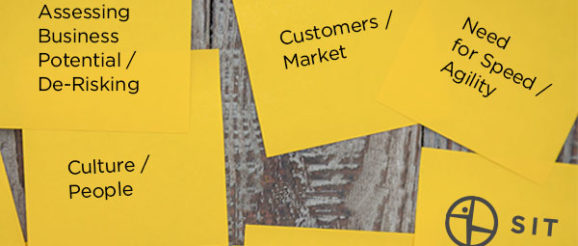4 Most Critical Innovation-Related Challenges

seems to us that although many companies have officially adopted an LSU process, they find it difficult to wean themselves off the habits of testing and seeking a high level of certitude for each specific innovation before launch.
“Lack of external leverage; too many options to choose from makes it even more difficult.”
2. How do we change our company’s culture/mindset?
The most common task these days goes way beyond launching a product, or even an entire product line. Key words are “culture”, “change” and “transformation”. The desire is to find ways to influence the entire organization, change strategies and business models.
SIT’s take: We’ve seen this process evolve in the past 24 years, from attention to a specific local result such as solving a problem or launching a single product, to the demand to generate an entire pipeline and roadmap, all the way to the current situation, in which CEOs and top management either realize the need or are pressured by their boards or stakeholders to lead transformational changes in their organizations. This can often lead to futile high-profile and costly changes-for-the-sake-of-changing, but, if well managed by a committed management team, can truly transform and invigorate a company.
“Focusing on long-term development, not the “right now”.
“Internal cultural shift necessary to transform our business model.”
3. How do we accelerate / acquire speed and agility?
Companies are not only pressured to change, but to change faster. This obviously places additional demands on managers, often accompanied by stress.
SIT’s take: a paradox ensues, whereby managers are expected to lead profound transformations, rather than superficial change, which requires time and patience; but, since the environment changes at an ever-accelerating pace– requiring rapid and immediate adaptations–there is less patience and resources for profound long-term change processes to take place.
“Innovation takes time to hatch. How do we innovate with the fast-paced environment?”
4. How do we listen and get closer to our customers?
After 30+ years of constant effort to get closer to the client, listen to the Voice of the Customer, observe, empathize, research and analyze, companies still feel that true understanding and insights tend to elude them, and therefore are searching for novel approaches.
SIT’s take: although true that innovation is useless unless it addresses a customer need, it is a mistake to believe that true innovation is born just from listening to VoC. We believe that being attuned to your customers is a necessary but not sufficient condition for innovation. Instead, we recommend a combination of: a) breaking the more-of-the-same-VoC mold by engaging with your customers proactively through co-creation exercises; b) using structured innovation methods to come up with initial ideas that are in turn validated with customers.
“Doing adequate research to uncover new problems.”
“Lack of customer interaction for directed innovation.”
To summarize, we found, not surprisingly, a high level of congruence between the most pressing innovation-related issues in a wide variety of organizations and positions. In the next two posts we will relate, respectively, SIT’s approach for dealing with these issues and some common traps and misconceptions when going about it.
